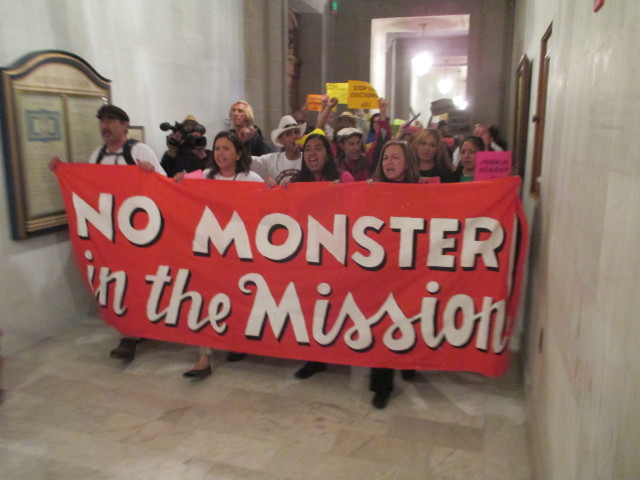The city’s own studies show that building luxury units causes more problems than it solves. Why is this not the defining issue in housing policy?

By Tim Redmond
JUNE 15, 2015 – Peter Cohen and Fernando Marti at the Council of Community Housing Organizations have dropped a bombshell on the standard City Hall analysis of affordable housing. In an oped in Sunday’s Examiner, the two explain how market-rate housing construction is NOT the main source of financing for affordable housing.
In fact, they note, the money that market-rate developers pay to subsidize affordable units doesn’t even cover the housing impacts that their projects create.
Let me say that again, because it’s critical (and not easily understood, and should have a profound impact on policies like the Mission Moratorium): If you require less than about 40 percent affordable housing, the net impact of high-end construction is to make the housing market worse.
How is that possible? How could building more housing (at any level) be a net problem for the housing market? Doesn’t more housing trickle down and make things better for everyone?
Well, no – not according to a City Planning Department study that is largely ignored in the debate.
Cohen and Marti mention it, but I want to go into more detail. The document is called a nexus study, and you can read it here. It’s not that complicated: When you build a new luxury housing complex, new resident move into it. For the most part, they result in net additions to the number of people in the city: If the person who buys a new condo moves out of a rental unit, someone else will move into that rental. Quickly.
The people with high disposable incomes who fill those condos or luxury rentals will spend money in town, creating a demand for jobs – restaurant workers, grocery clerks, cops and firefighters, bank tellers … and those people will also need a place to live.
(Sup. Scott Wiener notes that the city’s police force hasn’t kept up with the population growth. Perfect example – bring in 5,000 new wealthy residents, and the city faces pressure to hire more cops to protect them. Those cops cost tax money – but they also need places to live. And that puts pressure on the housing market).
So according to the study, by Keyser Marston Associates, every time the city allows 100 new high-end housing units, it needs to build between 20 and 43 new affordable units – just to keep the housing balance the way it is now. Put the affordable units in the main complex and the impact is lower (because fewer millionaires move in). Built them, as is common, somewhere else and the impact is greater.
In summary, for every 100 market rate condominium units there are 25.0 lower income households generated through the direct impact of the consumption of the condominium buyers and a total of 43.31 households if total direct, indirect, and induced impacts are counted in the analysis.
If the city demands 15 percent affordable set-asides, then every market-rate building adds more demand for affordable housing than it supplies. That means every new building makes the housing crisis worse.
Again: This isn’t me and some crazy leftists saying that. It’s the city’s own studies, done by a respecting economic consulting firm.
If anything, the numbers are way worse than they were when the study was done in 2007. The prices of housing are much higher, the wealth of the new residents much higher, the job-creations demands much higher – and the need for more affordable housing much higher.
We’re probably talking 50 percent here – half of all new units need to be affordable, not to make the crisis better but to keep it from getting even worse.
Market-rate housing not only doesn’t solve the problem – it helps create the problem.
Now, in the case of affordable units, it’s far more likely that they will go to existing residents – people who are currently homeless, or live in substandard conditions, or a packed five to a room. So building affordable housing doesn’t generate the kind of demand that market-rate housing does.
At the debate over the Mission Moratorium, Sup. Scott Wiener argued that stopping market-rate housing would cut off essential funding for below-market rate units.
But the city’s own studies show that that money is sucked up just mitigating the impacts that the luxury housing itself creates. So it creates no net new affordable housing.
Housing activist Calvin Welch points out that the data don’t show any trickle-down effect from building luxury housing: The more we build, the higher housing prices become.
The nexus study suggests one reason why.
Where does affordable housing come from? The two experts explain:
In 2011, at the low-point of market-rate housing production, The City produced (i.e. paid for) 207 affordable housing units, which was 59 percent of all housing built that year! While market-rate development was stalled because of a lack of finance capital from investors (who seem to refuse to finance any construction unless they can be guaranteed at least 25 percent returns on their investment), The City with its public funding sources continued to invest in affordable housing production. By contrast, there were 3,454 housing units built in 2014 of which 490 were affordable housing units, a mere 14 percent of total production. In other words, the “housing balance” was terrible. Affordable housing on balance got worse, not better, as the real estate market boomed.
There are other funding sources for BMR units – not enough, by a long stretch. But it’s not market-rate housing funding an increase in affordable units, and a moratorium on luxury units in the Mission won’t in any way damage affordable housing production, in that or any other neighborhood.
I suspect that will be part of the discussion when this issue comes back in three weeks.



